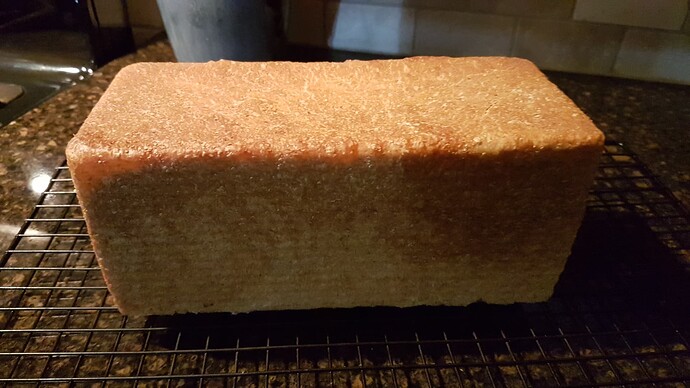Wow Melissa thanks for that video!
This makes sense to my science oriented brain. A basic understanding of the component starches lends insight to the overall dynamics at work.
The crumb was very soft and the two wheats together combined for a nutty, full bodied flavor- a novel taste for me. I dont quite have the bread vocabulary for a proper description- so I used the vineyard version. Buttered toast from this loaf is addictive.
Crusty Loaf used it to make a wholesome sandwich and it held its own with his tower of ingredients. He was out and contemplating a quick pick-up meal but instead came home to make a sandwich with your bread! Quite a turnaround for someone who considers drive thru offerings food.
And @Benito, thanks for the information about the scald’s inability to produce gluten. Your explanation enhances my understanding of the benefits and limits of a scald. Understanding these things provides purpose and direction in future experiments. I go off-script a lot because I use only fresh home milled flours.
As a new baker (who is also illness prone) I think I will make one type of scalded loaf per week in addition to other loaves. They are an ‘insurance policy’ that bread will always be available. I think I might try a combination with Kamut next. Any suggestions for the other flour- Einkorn, HWW, HRW. I also have rye, barley and buckwheat but these would not be strong enough- correct?
Melissa and Benny- I used both of your recipes in making Melissa’s Acorn Squash Bread. I went back and forth between them- I was using all wheat berries like Benny, but Melissa’s basic recipe. So they were both helpful and the resulting bread was wonderful.
I need to get my sourdough starter going so I can try Benny’s - I need it to make the levain.
In the video the chemist discusses ambient moisture’s role in staling of bread. This makes complete sense in the climate, at least of Japan. I spent 3mo there in 1991. The island nation is actually part of the same island chain that begins with Kilauea on Hilo, HI and migrates NW.
The islands are SO humid that the populace carry small very soft (and often designer) thin wash cloths with them everywhere for mopping foreheads. In this moist climate breads would then stale even faster- so scalding became a necessity (I am speculating). But provides a useful tool for us as well.
Amazing how experience, knowledge and application leads to ever more insights into our world.
Melissa, in retrospect I surmise I should had added milk immediately, prior to the rest. I appreciate small comments like “the dough will be very sticky’. Baring that I would have had no understanding as to why my dough was not yielding to slap & fold.
I have another question- I’ve experienced a problem with several types of shaping over many recipes - specifically that a dough will not stretch. One confounding experiment with breadsticks that would not form ropes (after BF) either by rubbing between my palms or on a counter- they sprang back into short strips.
I’ve had some success with laminating (which is likely why I used this method without consulting the recipe- I was just thinking- rectangle). But 1/2 the time the center portion in the of laminated dough does not get stretched. Should I compile the dough and begin the lamination again?
Then this dough, even after additional milk- would not lend itself to slap and fold or even shaping with a dough scraper- I usually have luck with that.
I have your gluten forming videos bookmarked and attempt all your techniques but never seem to get the stretch you demonstrate.
Is there a common denominator to this problem?
Thanks to you all!


